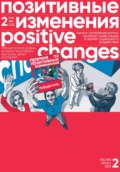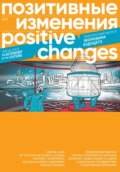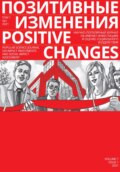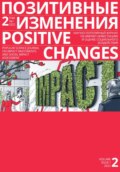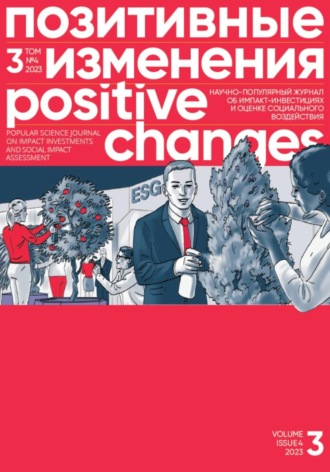
Редакция журнала «Позитивные изменения»
Позитивные изменения. Том 3, № 4 (2023). Positive changes. Volume 3, Issue 4(2023)
The Rorschach Test: The Role of Knowledge and Its Management in Philanthropic Organizations
Irina Efremova-Garth
DOI 10.55140/2782–5817–2023–3–4–58–67

“Knowledge as a Development Resource” – this was the theme chosen by the donor community for the year 2023, shaping the activities of Russia’s major grant-making organizations. The Donors Forum regularly held events dedicated to this topic for both its members and the public. The annual conference, held at the beginning of October, marked the pinnacle of these intellectual efforts.[107] Our expert’s article delves into the choice of this year’s theme, exploring how NGOs and commercial companies can preserve, interpret, and share their accumulated experiences, the value of knowledge in times of instability, the role of private and corporate donors in supporting science, and the future prospects of the knowledge sector.

Irina Efremova-Garth
Chief Sustainability Officer, Mobius Technologies
THE CORNERSTONE OF EFFECTIVE PHILANTHROPY
It wouldn’t be an overstatement to say that the success of donor organizations, which includes both private foundations and socially responsible companies, is directly linked to their human and intellectual capital. Knowledge stands as the cornerstone of effective philanthropy. It enables a strategic choice of funding priorities and investments in the most effective strategies for social change, while reducing administrative overheads and ensuring sustainability of the changes achieved. Over the years, these organizations have amassed extensive databases detailing various problem-solving approaches. However, experience shows that merely possessing data does not equate to gaining knowledge. For instance, one can spend years conducting grant competitions, training recipients, and collecting project reports, without ever being able to glean the key insights in the vast sea of data that could be instrumental in timely transforming grant programs, refining their priorities, and altering the ways of engaging with grant applicants and recipients.
What does it take to transform data into knowledge? Firstly, it involves learning how to collect and process data, incorporating it into the context of one’s activities, making it accessible, encouraging its exchange, and training staff in all these aspects. This necessitates establishing processes that allow an organization to accumulate and effectively manage its intellectual capital. Comprehensive knowledge management, both within individual organizations and across the sector, continues to be one of the major challenges for the donor community. Despite being a topic of discussion for many years, recent geopolitical and technological shifts have heightened its relevance and revealed new perspectives.
KNOWLEDGE AS A UNIVERSAL VALUE: THE VISIONARIES’ PERSPECTIVE
In a quest to understand knowledge management, explore a range of possible solutions, and find approaches that are compatible with the donor organizations’ corporate culture while addressing the nuances of our current reality, the Donors Forum chose “Knowledge as a Development Resource” as the theme for the donor community’s annual conference.
This unconventional topic called for innovative approaches. Therefore, instead of the traditional plenary session, the conference kicked off with a visionary discussion.[108] Experts from various fields, including science, spiritual development, and education, were invited to participate. They deliberated on how the value of knowledge changes in times of instability, how the donor community can meet new challenges and adapt to the pace of change without losing its sense. Drawing on their experiences, each speaker endeavored to reveal the multifaceted nature of this topic.
Sudha Rani Gupta, head of the Interregional Public Organization “Center for Spiritual Development” in Moscow, opines, “A time of crisis can be a period of grace. To face it calmly, one needs an understanding of the world’s history, its dramas, and the global spectacle… Today, there are numerous schools and teachers, but profound ignorance also exists, because people are unaware of their true selves. This ignorance is the root of conflicts and wars. The much-needed knowledge now is the kind that liberates individuals from vices and enables them to adopt values and virtues that truly humanize their lives.”
Comprehensive knowledge management, both within individual organizations and across the sector, continues to be one of the major challenges for the donor community.
Lyubov Dukhanina, Doctor of Pedagogical Sciences, Professor, and Chair of the Council for Professional Qualifications in Education, is convinced that the true value of knowledge lies not in the knowledge itself but in how it impacts our understanding of the world. “My role is to help children acquire knowledge and recognize its significance at the cultural code level. In an era rife with geopolitical and technological challenges, the speed of learning has never been more crucial. In this context, mentorship emerges as one of the fastest methods of knowledge transfer and acquisition. However, what we need is not just people replicating existing models, but creating new ones. It is therefore particularly valuable when a child or young adult has a mentor from the realms of science and the arts – an individual capable of teaching the creation of new knowledge,” Dukhanina says.
Alexei Semikhatov, Doctor of Physical and Mathematical Sciences, Head of the Laboratory of the Theory of Fundamental Interactions, Lebedev Physical Institute, Russian Academy of Sciences, formulates the nature of knowledge as follows: “Knowledge is a renewable and inexhaustible resource. Knowledge is not an on-shelf product. And it is essentially boundless.” Describing the unique feature of knowledge, he adds that “engaging with knowledge is an active process. Its main value lies in how it transforms the learner. Real [meaning for] knowledge starts where textbooks end, and a unique feature of us as humans is the ability to navigate the uncharted territories of scientific papers yet unwritten, results yet unformulated, and hypotheses yet unshaped.”
Exploring one’s identity is a crucial issue, not only for a person but also for every organization or a company that tries thinking strategically.
All the experts agreed that what is known in the corporate world as diversity and inclusion (D&I) are vital principles for generating new knowledge, whether we are talking about individuals or systems of values and outlooks. This approach recognizes the importance of factoring in everyone’s experiences, characteristics, and viewpoints at all organizational levels, adding value to the organization’s ultimate products.
Semikhatov underscores, “It is important that different generations be represented in any team producing new knowledge. This is because knowledge creation does not happen top-down following instructions, but requires continuity in the teaching/learning paradigm.”
Dukhanina also emphasizes the importance of diverse perspectives: “Exploring one’s identity is a crucial issue, not only for a person but also for every organization or a company that tries thinking strategically. It is extremely important to allow visibility for a spectrum of different viewpoints.”
ADAPTING KNOWLEDGE TO EXTERNAL CHANGES
Shifting the focus to practical considerations, it is crucial for donor organizations not only to comprehend the role of knowledge in their sector but also to acknowledge how external factors (such as the emphasis on sustainable development, mounting staff shortages, and the trend towards technological sovereignty) impact and challenge the established knowledge management practices. These issues were central to the panel session at the conference “Priceless Cargo: Organizing the Accumulation, Management, and Transfer of Knowledge and Competencies in the Sector,”[109] where participants shared their insights and strategies for enhancing the maturity of knowledge management processes, methods of knowledge accumulation, and technologies for knowledge transfer.
It is crucial for donor organizations not only to comprehend the role of knowledge in their sector but also to acknowledge how external factors impact the established knowledge management practices.
The challenges identified in preserving and transferring a large body of knowledge in the rapidly changing conditions include:
• Lack of Structured Information: The information donor organizations often have to deal with is usually heterogeneous and poorly organized information. This applies to contextual data critical for understanding key aspects of the funding environment and data that illuminates the impact of funding. The scarcity of structured information poses significant challenges in developing a knowledge management system, particularly in categorizing information logically or thematically.
• Access to Reliable and Current Information: Employees in foundations and Corporate Social Responsibility (CSR) departments often lack access to a broad spectrum of information, including research, best practices, and success stories relevant to their work areas. Furthermore, the information at hand is not necessarily compliant with the quality standards, current, or even practically useful. In the fast-evolving field of social innovation which the donor organizations are investing in, information becomes outdated quickly, necessitating mechanisms for ongoing updates and evaluation of information within an organization and in the community at large.
• Data Security: Knowledge management systems must be safeguarded against unauthorized access. Their staff must possess the knowledge and skills to maintain confidentiality of sensitive information, such as personal data about donors and beneficiaries.
Donor organizations need to measure the effectiveness of their knowledge management systems, assessing how well they aid in achieving goals.
• Measuring Knowledge Management System Effectiveness: Donor organizations need to measure the effectiveness of their knowledge management systems, assessing how well they aid in achieving goals and maximizing social impact. This requires:
1) A unified stance and clear understanding among the management team regarding the benefits of knowledge and knowledge management system.
2) Competence in setting appropriate goals and planning outcomes for the process.
3) Skills in developing effective performance indicators.
4) A commitment to invest in monitoring processes for tracking the progress towards achieving the goals and the returns on investment in the knowledge management system.
• Fostering a Knowledge Management Culture for Collective Benefit: It is widely accepted today that strategic philanthropy depends on reliable information. Foundations and socially responsible companies have been gathering data for years, but to truly benefit and elevate their operations, a more challenging task lies ahead – developing a knowledge management culture within the donor community. This, of course, involves employee training and establishing mechanisms for knowledge exchange among organizations.
Inga Moiseeva, CEO of the Development Group consulting agency, observes, “Knowledge is the product of donors’ activities; it is part of social technology and the foundation of our work approach.”
Having a robust knowledge management process helps rapidly growing organizations stay grounded, adhere to their mission, and remain the institution their founders had envisaged them to be. Institutionalizing the knowledge management process involves developing specific principles, policies, and guidelines regulating this activity. The Potanin Foundation has a notable experience in this regard. They have crafted an internal policy that defines their approach to knowledge management. This document not only outlines the foundation’s definition of “knowledge” as “information about successful models, lessons learned, tested approaches and tools, potential risks and challenges that helps the foundation, its partners and beneficiaries to make their operations more efficient…,”[110] but also establishes principles for managing this valuable asset. These types of documents lay the groundwork for a culture of knowledge within an organization, involving all staff in the process. As stated in the document, “Knowledge management is a collective effort. The entire team of the Foundation participates to some extent in creating, capturing, disseminating, and utilizing knowledge to enhance work efficiency.”
Institutionalizing the knowledge management process involves developing specific principles, policies, and guidelines regulating this activity.
Svetlana Gerasimova, Partner of the Project Office “Strategies and Practices of Sustainable Development,” argues that learning from others’ cases is nearly impossible. “Consider the knowledge pyramid, which comprises practice, concept, and theory. Those at the practice level believe learning is only possible through hands-on experience. However, come to think of it, learning from others’ cases is not really feasible. You might gain analysis and benchmarks, but your environment, situation, resources, and people will inevitably be different. Learning requires a different level – that of conceptual understanding, where we can draw conclusions from practice. Even fewer people reach the theoretical level, either overlooking its importance or forgetting it, even though it is crucial for making predictions about future developments.”
DONORS AS DRIVERS OF PROGRESS
In discussing knowledge, it is essential to address the practices of investing in science in Russia and worldwide.
According to a study titled “The Role of Philanthropy and CSR in Supporting Science in Russia and Worldwide,” conducted by independent experts as part of the “Dialog Formula” project supported by the Presidential Grants Fund, Russia ranks second globally in state funding of science, at 67.8 %, just behind Mexico. In contrast, private funding for scientific research in other countries can reach up to 70 %. The Accounts Chamber of the Russian Federation, based on its monitoring of the progress of events being part of the “Science” National Project,[111] highlights the importance of not just planning for extrabudgetary funds but also developing mechanisms to attract private investments in collaboration with donors.
At the conference session “Donors as Drivers of Progress: Practices of Investing in Science in Russia and Worldwide,” the participants discussed private funding practices, the potential for integrating donor efforts in supporting science, and the challenges they face.[112] Experts taking part in the discussion suggested addressing intellectual property management issues, considering tax incentives to stimulate business interest in funding research, engaging all stakeholders in the dialog, and creating platforms for donors and science advocates to share experiences. These measures could foster an ecosystem facilitating the development of new knowledge and increasing private investments in science.
The Dialog Formula project,[113] initiated by the donor community in 2022, exemplifies the formation of new knowledge. Its goal is to develop philanthropic support for scientific projects in Russia amidst the country’s current challenges. This project integrates various activities for analyzing existing experience, creating new knowledge, and facilitating knowledge exchange through a dialog within the donor community, as well as between science and charity foundations’ representatives.
Russia ranks second globally in state funding of science, at 67.8 %, just behind Mexico.
Interestingly, the Donors Forum is not the only professional association aiding philanthropic organizations and socially responsible companies in establishing dialog with the science community to enhance the quality of investment in science. Similar initiatives exist in many countries. The Science[114] n the USA exemplifies such initiatives. It started a decade ago as a partnership between six major philanthropic institutions, which decided to join their efforts to offset a decline in the government funding for scientific research. Nowadays, the Alliance comprises over thirty foundations and philanthropic institutions, each investing between $200 million to $18 billion annually in science. Alliance membership allows sharing best practices and staying up to date on the most effective support models for fundamental science. In addition to directly funding scientific research, members address issues like open-source scientific data and gender representation in science, etc. One of the challenges being addressed by the Alliance members is the measurement of the impact of philanthropic support on fundamental scientific research. Unlike other sectors, the timeline for impact on technology or health in science can span decades, and effects may be manifested in areas distinct from where the original scientific breakthrough took place. To tackle this challenge, members of the Alliance have collaboratively developed a system of methods to assess the impact of their support. These methodologies serve the broader philanthropic community, aiding donors in selecting work practices and approaches that provide sufficient assurance that their contributions are truly impactful. Over the past decade, the Alliance has built a robust scientific-philanthropic community, facilitating networking, collaborative learning, and exploration of partnerships. Its events are now key benefits for many Alliance members, as they enhance knowledge sharing and respectively return on investment.
Donors universally recognize that knowledge, not money, is today’s primary competitive advantage and development resource for themselves and their partners.
There are virtually no donor organizations left today that have not come across the issue of knowledge creation and management, in one form or another. However, this activity area still poses clarity challenges to many fund leaders and corporate social responsibility managers. It has become a sort of Rorschach test for the donor community: some view knowledge management as simply administering information systems, others see it rather as employee behavior management, while still others prioritize the development of communication channels. Despite varying approaches, donors universally recognize that knowledge, not money, is today’s primary competitive advantage and development resource, benefiting not only themselves but also their partners and beneficiaries.
Storymining: как истории помогают в оценке и чем они еще полезны в социальном проектировании
Анна Ермягина
DOI 10.55140/2782–5817–2023–3–4–68–77

Большинство людей привыкли считать сторителлинг инструментом маркетинга, когда задача сводится к придумыванию увлекательной истории, способной привлечь внимание. Но эксперты, много лет работающие с историями, уверены, что их применение простирается гораздо шире. Сторителлинг в оценке – один из трендов последних лет. Неслучайно конференция Американского общества оценки в 2023 году была посвящена силе историй. Как превратить истории в данные и смыслы, и для чего сторителлинг может использоваться в оценке социальных проектов и программ – в статье нашего автора.

Анна Ермягина
Партнер и консультант Академии Historia, тренер по сторителлингу в бизнесе
THE POWER OF STORY
Говоря об оценке воздействия, сложно обойтись без историй изменений – о том, как меняется жизнь благополучателей, стейкхолдеров, заинтересованных сторон и всех, для кого проектная интервенция стала началом чего-то важного и нового, фактором, вызвавшим значимые изменения. И если при оценке непосредственных результатов в нашем распоряжении есть только безликие цифры – количество мероприятий, количество людей, количество просмотров и т. п., то особенностью оценки воздействия (импакта) является то, что за этими цифрами мы стараемся разглядеть истории изменений в жизни, здоровье, благополучии конкретного человека, семьи, сообщества, а иногда даже – целого региона или даже страны в целом.
Неслучайно именно историям, а точнее силе историй была посвящена конференция Американского общества оценки, которая прошла 9–14 октября этого года[115]. «Кратчайшим расстоянием между двумя людьми является история», – так прозвучало одно из ключевых сообщений конференции. Другими инсайтами конференции стали «Равенство – это принцип, инклюзия – это действие, разнообразие – это факт», «История – это то, что происходит сейчас», а также «Искусственный интеллект для нас, а не мы для него»[116]. И все же большинство сессий этого года были посвящены размышлениям о том, какой вклад сторителлинг вносит в понимание и процесс оценивания проектов, а также более глубокому изучению использования сторителлинга и его преимуществ.
Вышеупомянутая фраза, ставшая лейтмотивом конференции, принадлежит американской писательнице Патти Диг: она выражает идею, что, рассказывая друг другу свои истории, мы можем лучше понять и сблизиться с другими людьми.
Истории, которыми мы делимся, являются прямым отражением происходящих с нами событий, нашей интерпретации и отношения к происходящему. Чем не идеальный материал для использования в оценке социальных проектов и программ?
Под историями для оценки мы подразумеваем краткие повествования чьего-либо опыта, связанного с проектом, мероприятием или определенным видом деятельности. «Собирая» такие истории, мы можем не только увидеть проект изнутри глазами благополучателей, выделить сопутствующие эффекты и социальные результаты, но и понять мотивацию, ценности, эмоции и другие факторы, оказавшие влияние на результат. Почему это важно? Истории помогают определить, почему эти изменения происходят или не происходят, каков механизм их достижения.
При проведении оценки также важно, чтобы процесс сбора данных проходил максимально комфортно и доверительно, а еще лучше – походил на разговор по душам. Одним из подходящих для этого инструментов является круг историй – групповая встреча, где участники делятся друг с другом своими историями.
STORYMINING: ДОБЫВАЕМ ЦЕННЫЕ ИСТОРИИ
Технически встреча по модели «круг историй» выглядит так: участники садятся в круг лицом друг к другу и по очереди рассказывают истории. При этом организация и проведение такой встречи предполагают несколько этапов[117]:
1. Определитесь с фреймом
Прежде чем созвать круг, вы должны определиться с фреймом – кого вы собираете, для чего вы собираете этих людей и предлагаете им рассказывать истории? На круг, в зависимости от цели, можно собрать текущих благополучателей проекта, проектную команду, будущих благополучателей с целью изучения их мнений, потребностей и т. п. Не ограничивайтесь историями непосредственных благополучателей. Подумайте о возможности участия в кругах историй, например, их родственников и других людей, которые могут также стать носителями важных историй о проекте.
Приглашая участников, сообщите им цель, например: «Мы собираемся позвать вас на небольшую встречу для того, чтобы вы и другие участники проекта послушали друг друга и поделились опытом, который вы уже успели получить в процессе его реализации».
2. Найдите или создайте «третье место»
Если вы планируете провести круг историй очно, тогда следует найти место, которое способствует открытости и не является офисом организации, инициировавшей проект, или залом, где проходили мероприятия в рамках проекта. Это может быть поляна на свежем воздухе, уютный зал в антикафе или обычный рабочий кабинет. Главное здесь – отодвинуться от столов и сесть лицом друг к другу для эффекта полноценного присутствия.
Если нет возможности собрать участников очно – можно провести круг онлайн. Для этого подойдет любое приложение для удаленных встреч: Zoom, Google Meets и другие.
3. Разбейте всех участников на мини-группы
Лучше, чтобы участники работали небольшими группами по четыре-пять человек: так проще услышать историю каждого и ничего не упустить. Пусть в каждой мини-группе соберутся разные люди, выбранные случайным образом.
Чтобы услышать от людей истории, подумайте заранее о наводящих вопросах, которые помогут им вспомнить ключевые события. Запишите 2–3 таких вопроса на флипчарте, если проводите круг очно, или выведите на слайд презентации, если встреча проходит онлайн.
Далее дайте участникам краткую инструкцию: «Сейчас я покажу вам несколько вопросов-подсказок. Не спешите, внимательно прочитайте вопросы и вспомните одно событие с помощью одного из них. Событие не обязательно должно быть масштабным – оно может быть совсем небольшим и тем не менее несущим важный смысл».
4. Начните круг историй
Спросите участников, у всех ли получилось вспомнить конкретное событие. Если кто-то из участников качает головой, скажите, что истории часто рождаются в ответ на историю другого – а значит, как только начнется обмен, своя история тоже вспомнится. Далее выведите на экран краткую инструкцию по обмену историями. Она может выглядеть так:
• Первый рассказчик в группе делится своим воспоминанием. Другие участники внимательно слушают. На один рассказ – 5 минут.
• После этого слушатели откликаются на историю с помощью обратной связи. Какие для этого можно использовать предложения вы найдете ниже в этой статье – в параграфе про «Коллективный сбор урожая».
• Рассказчик говорит, что ему больше всего откликнулось в словах слушателей.
• Далее вы переходите к следующему рассказчику и продолжаете обмен историями.
Ниже мы рассмотрим, как превратить услышанные истории в кладезь ценных данных.
ВОПРОСЫ-ПОДСКАЗКИ ДЛЯ ПОИСКА ИСТОРИЙ
Международный эксперт по стратегическому сторителлингу и автор книги «9 техник сторителлинга» Дэвид Хатченс (David Hutchens), который уже более 30 лет обучает лидеров организаций работать с историями, говорит: «Слова история и сторителлинг вызывают у многих людей оцепенение: «Какие истории?! У меня нет никаких историй!» Истории появляются естественным образом, и это происходит постоянно, но пытаться выудить их из людей – это все равно что звать застенчивого ребенка, который не желает выходить из своей комнаты. Иногда я вообще не использую термины история или сторителлинг. Порой лучше просто начать рассказывать истории, не привлекая внимания к тому факту, что мы этим занимаемся».
Поэтому в работе с историями вопросы-подсказки играют ключевую роль. Вот один из способов пригласить людей начать рассказывать: «Расскажите о случае / эпизоде / моменте / периоде из вашей жизни…»
Это классическая подсказка для поиска историй. Когда вы говорите: «Расскажите о…», то направляете внимание людей на линейный, временной континуум, где как раз и живут истории. Кроме того, такая формулировка подчеркивает факт, что мы ищем специфическое событие.
Для того чтобы услышать истории благополучателей о проекте, можно использовать следующие вопросы. Оговоримся, что с помощью них мы не программируем ответы. Эти вопросы необходимы для поиска точного, конкретного события на временной линии прошлого в памяти. Событие может быть совсем небольшим, даже крохотным изменением – тем важнее, если оно не затеряется, а вспомнится. Если кто-то из участников не может ничего вспомнить, предложите ему послушать других участников и тогда, скорее всего, ему тоже удастся вызвать из памяти конкретный эпизод. Если большинство участников не могут вспомнить ничего подходящего, тогда это хороший повод провести круг историй с авторами программы и понять, на что и как они хотели повлиять данной программой и каких результатов добиться.
• Расскажите о моменте, когда вы с улыбкой подумали: «Как же здорово, что этого стало больше / это стало происходить чаще!» Что происходило?
• Расскажите о случае, когда вы с удивлением и радостью подумали: «А ведь моя жизнь действительно в последнее время изменилась к лучшему и проект способствовал этим изменениям». Что конкретно изменилось? Как это происходило?
• Изначально мы не всегда уверены в том, что проект что-то даст – и это абсолютно нормально. Но порой в процессе мы убеждаемся, что он полезен для нас. Расскажите о моменте, после которого ваши сомнения в ценности проекта развеялись. Что происходило?
Чтобы услышать истории проектной команды и рассмотреть проект с их перспективы, можно использовать вопросы:
• Расскажите о моменте, когда, выходя с работы, вы подумали с улыбкой: «Ради таких изменений я готов и бесплатно работать!» Что происходило?
• Вспомните о моменте, когда вам стало по-настоящему тепло на душе от того, что благодаря вашей работе и этому проекту жизнь другого человека стала хотя бы чуточку лучше. Что происходило?
• Не всегда работа приносит вдохновение – чаще случаются обычные рутинные дни. Вспомните момент, когда, работая в обычном режиме, вы вдруг почувствовали прилив вдохновения, потому что увидели/осознали, какую пользу ваша работа несет другим. Что вы увидели? Что происходило?
• Что недавно заставило вас гордиться своей организацией/ командой? Поделитесь конкретным случаем, который помог вам почувствовать удовлетворение в конце дня – настолько, что вы не могли дождаться, когда расскажете об этом близким людям, супругу, другим членам семьи или друзьям.
Истории о моментах, которые нуждаются в корректировке, можно отыскать с помощью вопросов (их можно задать и благополучателям, и людям, которые работали над программой):
• Расскажите об эпизоде, когда, глядя на ход реализации проекта, вы подумали: «Вот это работает хорошо, а вот это надо бы сделать по-другому». Что вы заметили? Что происходило?
• Расскажите о случае, когда вы поняли, что в ходе планирования проекта, допустили ошибку / неправильно выбрали фокус, но эта ошибка помогла вам выявить нечто важное. Что происходило? К каким выводам вы пришли?
• Расскажите о моменте, когда вы осознали, что, к сожалению, проект не всемогущ и не может решить всех текущих проблем благополучателей. Как вы это поняли? На что вы обратили внимание? Что происходило?
• Расскажите об эпизоде, когда вы заметили, что проект работает не так, как вы ожидали. Что происходило? Какие ваши ожидания не оправдались?
• Расскажите о случае, когда вы увидели, что проект, решая одну проблему, выявляет другую – более глубокую проблему, о которой вы ранее не задумывались. Что происходило? Как вы это заметили?



